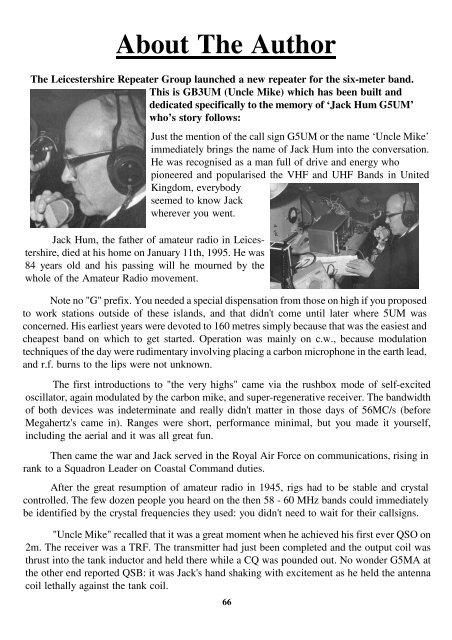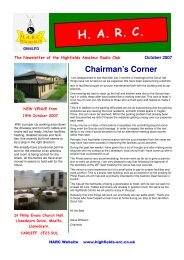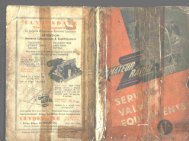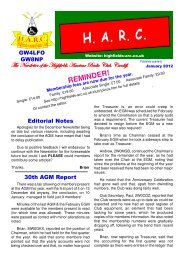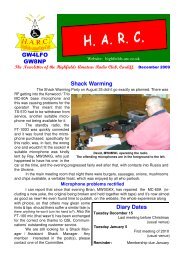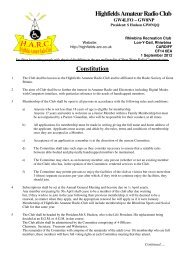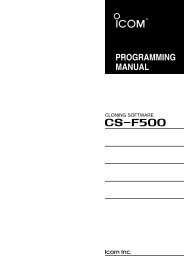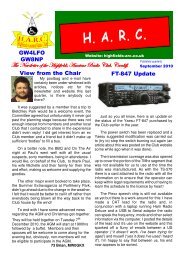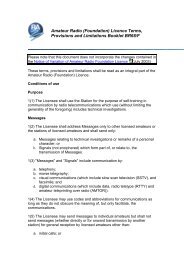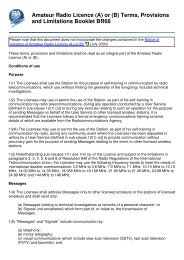CALL BOOK 1920 - 1930 - Highfields Amateur Radio Club
CALL BOOK 1920 - 1930 - Highfields Amateur Radio Club
CALL BOOK 1920 - 1930 - Highfields Amateur Radio Club
You also want an ePaper? Increase the reach of your titles
YUMPU automatically turns print PDFs into web optimized ePapers that Google loves.
About The Author<br />
The Leicestershire Repeater Group launched a new repeater for the six-meter band.<br />
This is GB3UM (Uncle Mike) which has been built and<br />
dedicated specifically to the memory of ‘Jack Hum G5UM’<br />
who’s story follows:<br />
Jack Hum, the father of amateur radio in Leicestershire,<br />
died at his home on January 11th, 1995. He was<br />
84 years old and his passing will he mourned by the<br />
whole of the <strong>Amateur</strong> <strong>Radio</strong> movement.<br />
Just the mention of the call sign G5UM or the name ‘Uncle Mike’<br />
immediately brings the name of Jack Hum into the conversation.<br />
He was recognised as a man full of drive and energy who<br />
pioneered and popularised the VHF and UHF Bands in United<br />
Kingdom, everybody<br />
seemed to know Jack<br />
wherever you went.<br />
Note no "G" prefix. You needed a special dispensation from those on high if you proposed<br />
to work stations outside of these islands, and that didn't come until later where 5UM was<br />
concerned. His earliest years were devoted to 160 metres simply because that was the easiest and<br />
cheapest band on which to get started. Operation was mainly on c.w., because modulation<br />
techniques of the day were rudimentary involving placing a carbon microphone in the earth lead,<br />
and r.f. burns to the lips were not unknown.<br />
The first introductions to "the very highs" came via the rushbox mode of self-excited<br />
oscillator, again modulated by the carbon mike, and super-regenerative receiver. The bandwidth<br />
of both devices was indeterminate and really didn't matter in those days of 56MC/s (before<br />
Megahertz's came in). Ranges were short, performance minimal, but you made it yourself,<br />
including the aerial and it was all great fun.<br />
Then came the war and Jack served in the Royal Air Force on communications, rising in<br />
rank to a Squadron Leader on Coastal Command duties.<br />
After the great resumption of amateur radio in 1945, rigs had to be stable and crystal<br />
controlled. The few dozen people you heard on the then 58 - 60 MHz bands could immediately<br />
be identified by the crystal frequencies they used: you didn't need to wait for their callsigns.<br />
"Uncle Mike" recalled that it was a great moment when he achieved his first ever QSO on<br />
2m. The receiver was a TRF. The transmitter had just been completed and the output coil was<br />
thrust into the tank inductor and held there while a CQ was pounded out. No wonder G5MA at<br />
the other end reported QSB: it was Jack's hand shaking with excitement as he held the antenna<br />
coil lethally against the tank coil.<br />
66


